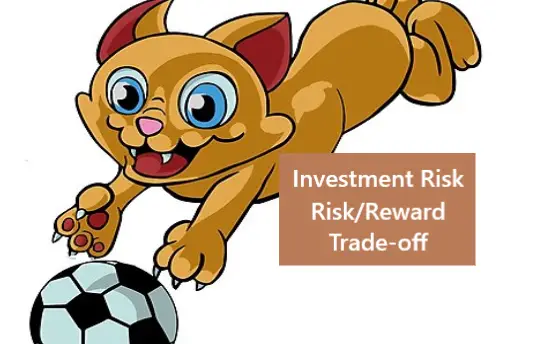The Risk/Reward Trade-off
As you construct your portfolio, where do you take risk? Should you take risk in your Equities or your Bonds?
Risk means different things to different people, but without some risk, there is no reward. This isn’t your risk tolerance; it is why and where you take that risk.
How much risk is required for what kind of reward? What is the Investment Risk/Reward Trade-off?
Risk/Reward Trade-off
Investment Risk is the decision to put your money to work. Since there is no free lunch, you lose spending power to inflation any time you have cash sitting around.
You can’t do two different things with the same money. Investment risk helps inform you what to do- it’s a risk/return trade-off. When you take a risk—like investing—you do so because you expect a reward—a monetary gain above inflation.
When investing, risk means the probability of a loss or the probability of an asset providing less than the expected return.
This is not standard deviation—or volatility—which is often considered a risk. Volatility is the short-term ups and downs of an asset. While short-term losses feel horrendous and cause poor investing hygiene (such as selling low and locking in losses), the risk/return trade-off infers more of an intermediate or longer time frame.
Should I Accept Investment Risk?
Some folks don’t need investment risk in their portfolio. They don’t understand and can’t tolerate volatility and don’t invest in equities and bonds. They believe stocks and bonds are high-risk investments and they have a lack of control.
They invest in what they consider lower-risk assets, where they can have more control. Sometimes real assets—real estate, metals, tangibles, businesses, etc. For some, stocks are too risky, and they want more control.
The stock market goes up over time. You only lose money if you sell low and lock in losses.
Once you understand that volatility doesn’t equal, you are one step ahead of those who avoid risk investing.
If you view equities as reasonable investments, not too risky, where should you take your investment risk? In stocks or bonds?
Investment Risk Location—Where to take Risk in your Portfolio
The risk/return trade-off implies that you take risk and expect higher returns. These are the two sides to the trade-off.
Where should you go looking for risk in your portfolio, understanding that the goal is to grow faster than inflation plus a return on your investment?
Do you look towards your low-risk / low-return bonds? Or your high-risk / high-return stocks? Are bonds low risk?
When considering Risk Location—where you take your investment risk—asset allocation and asset selection both come into play. You choose your asset allocation—the percentage of stocks vs. bonds in your portfolio—and choose which individual investments to invest in. Both address risk.
Bonds can be risk-free or high-risk. Respectively, this spectrum ranges from ultra-safe treasury bills to junk (high-yield) bonds. Do you chase yield in bonds or take your investment risk in stocks and look to bonds just for safety?
Bonds, by their very nature, seem low risk compared to stocks. But is that true? It depends on what you mean by risk.
When Low Risk is High Risk
Say you cannot stomach volatility and are invested in 100% bonds. Here, the risk is not volatility but accomplishing your investing goals! You might never have enough to retire.
The Risk/Return Trade-off implies that a 100% bond portfolio has such “low risk” that you are at high risk of failure. Future expected returns must be considered.
When High Risk is Low Risk
On the flip side, why not invest in 100% equities? If you can stomach the volatility, this is a low-risk play. Young investors have no investment risk if they don’t sell.
It all depends on your goals. Which not infrequently depends on your age.
Chasing Yield for the Young
For the young who dollar cost average into their retirement accounts, you don’t have investment risk if you don’t sell stocks for decades.
Invest in assets with the highest long-term expected returns regardless of the volatility. Again, the risk is not volatility but panicking and selling low.
Risk location for the young can be a high-risk allocation (high stock to bond asset allocation). In addition, select asset sub-classes with higher expected future returns within the stock allocation.
This includes ‘tilts’ such as small cap, value, emerging markets, real estate, momentum, and the like. These have higher expected future returns because they are more volatile.
What if you aren’t young anymore?
Chasing Yield during De-Accumulation
What about someone who is in de-accumulation? Spending down your portfolio feels very different than saving. Sequence of Return Risk weighs heavily.
Sequence of Returns Risk implies a prolonged series of negative market returns while you are taking withdrawals. Only if this sequence occurs right around retirement is it a problem, but you have to assume it will hit you and move on when it doesn’t.
Risk allocation for those in de-accumulation means being more conservative. No 110 minus your age crap, but have enough safer assets. Then, take distributions from your assets that are doing well.
Harvest from your winners to allow the downtrodden time to revert to the mean.
Are Bonds Low Risk?
So, fundamentally, here is the point: bonds are not low risk.
Or, sometimes, they have a poor risk/reward trade-off. The reward (Chasing Yield) is low, and you must take too much risk to make the reward acceptable. Don’t chase yield. by taking more risk. Bonds–or your “safer assets”- are not the location in your portfolio for risk.
If you need a higher return, increase your stock allocation rather than taking risk in your bond allocation.
Investment Risk Location and the Risk/Return Trade-off
So, the risk/return trade-off means risk location matters. Take investment risk in equities rather than bonds.
Young folks have time. Older folks have bonds which buy them time.
Where should you take risk when considering an asset allocation of bonds and stocks?

